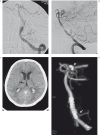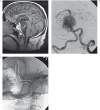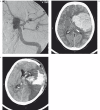Complications in the treatment of intracranial aneurysms with silk stents: an analysis of 30 consecutive patients
- PMID: 23217636
- PMCID: PMC3520555
- DOI: 10.1177/159101991201800407
Complications in the treatment of intracranial aneurysms with silk stents: an analysis of 30 consecutive patients
Abstract
Flow-diverting stents (Silk and PED) have radically changed the approach to intracranial aneurysm treatment from the use of endosaccular materials to use of an extraaneurysmal endoluminal device. However, much debate surrounds the most appropriate indications for the use of FD stents and the problems raised by several possible complications.We analysed our technical difficulties and the early (less than ten days after treatment) and late complications encountered in 30 aneurysms treated comprising 13 giant lesions, 12 large, five with maximum diameters <10 mm and one blister-like aneurysm. In our experience the primary indications for the use of FD stents can be the symptomatic intracavernous giant aneurysms. Although the extracavernous carotid siphon aneurysms have major risk of bleeding, FD stents are indicated clearly explaining the risks to the patient in case of severe mass effect. There is a very complex assessment for aneurysms of the vertebrobasilar circulation.
Figures









References
Publication types
MeSH terms
Substances
LinkOut - more resources
Full Text Sources
Medical

